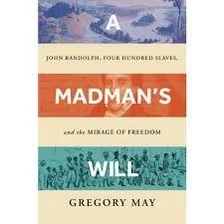REVIEW: A Virginia Slaveowner Freed His Slaves. The Rest of the Story is Complicated.
/A Madman’s Will: John Randolph, 400 Slaves, and the Mirage of Freedom
By Gregory May
Liveright, 416 pp.
Review by Jim Swearingen
Historically, White Americans have largely dithered whenever the freedom and equality of Black Americans was at stake. If cotton was king in mid-19th century America, it rested on the backs of four million Black slaves. And for a race that created much of this nation’s early capital, Whites consistently repudiated the Constitution’s promise of liberty. Any attempt to upset that economic precondition met with legal, often lethal, White resistance.
Historian and lawyer Gregory May’s new book, A Madman’s Will, documents the 13-year legal battle that ensued when John Randolph, a Virginia planter and former U.S. Senator, freed nearly 400 slaves upon his death in 1833. A notorious advocate of Republicanism and slavery in the United States Senate, Randolph had built what was, for the times, an unusually solvent plantation back home. Yet with age, Randolph had increasingly shown signs of mental imbalance and paranoid behavior. Whether insane, as some feared, or merely erratic, he had vacillated throughout his life between the seemingly contradictory positions of defending “the peculiar institution” while planning to manumit all of his own slaves upon his death.
When Randolph died, he left behind a probate judge’s nightmare of capricious wills, codicils, and unsigned letters declaring his post-mortem intentions. Each document attracted its own team of self-interested White proponents, initiating a long judicial slog that tortured Randolph’s putative beneficiaries over the next decade.
May delves into the Faulkneresque secrets hibernating in Randolph’s convoluted Southern family: stepparents and cousins, inheritances and insolvencies, bottomland and slave quarters, dubious sexuality and rumored abortions. The Randolph family war over their inheritances reads like a Southern gothic version of Charles Dickens’ Bleak House.
What really drives May’s juristic melodrama, beyond all of the dollar signs, is the issue of whether Randolph meant to free his slaves, or did so in a fit of insanity, and secondarily, whether the Virginia courts could allow such a large manumission to undermine the prevailing argument that slavery was beneficial to those in bondage. If slavery was such a boon to enslaved people, why would the courts facilitate their release, particularly when their cash value constituted such a large portion of Randolph’s contested estate?
Randolph’s slaves were ultimately granted their freedom in 1846, and when they were the majority of them headed for Ohio to settle on land purchased for them by Randolph’s lawyer. The national media frenzy over the will’s long-awaited resolution alerted towns and vigilante councils along the route to their imminent arrival. When they finally reached their new home after an arduous trek through the inhospitable Virginia countryside, their new Ohio neighbors expelled them.
That left Randolph’s freed slaves in an awful limbo. The rise of Black Laws, which restricted the movements and legal rights of freed slaves, left them with literally nowhere–in America–to go. As Northern states like Ohio barred the admission of most free Blacks, Dixie passed laws banishing freedmen who, they feared, would agitate among those still in bondage. White men on both sides of the Mason-Dixon feared the economic and social chaos that emancipation would likely bring.
In telling this gripping story, May also helps us better understand the colonization movement, which sought to relocate freed slaves to Liberia. This was not the back-to-Africa ideology that later aroused 20th century Blacks disillusioned about ever being able to participate fully in American democracy. Colonization was originally a White idea, rationalized by Whites and funded by them. Many of its proponents feared that racial prejudice in America would never abate on either side, leaving the country in a state of perpetual racial turmoil.
May exercises considerable discipline in examining Randolph and his contemporaries in the context of their times, resisting the temptation to judge motives and opinions through a modern sensibility. He opts to let court records, letters, newspaper accounts, and contemporary interviews report the literal thoughts of the day. The evidence of widespread indifference to the plight of Randolph’s slaves, particularly the rapid dying off or selling off of those who were parties to the suits for manumission, establishes a moral indictment without the historian’s direct condemnation.
We may think of justice deferred through a numbing series of procedural and tactical delays as a modern phenomenon. Gregory May shows us that freedom has always been a mirage when racial profit hangs in the balance. In a nation so ill-prepared to accept racial equality, John Randolph’s unusual gesture did little to prepare his slaves for the inhospitable freedom to come.
Jim Swearingen is a Minneapolis-based writer.










